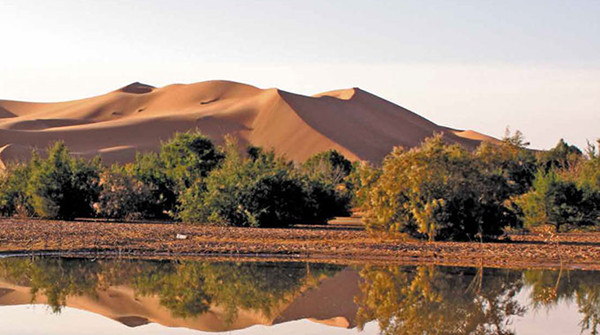Atlas shows environmental change in Arab
 0 Comment(s)
0 Comment(s) Print
Print E-mail UNEP, December 11, 2013
E-mail UNEP, December 11, 2013
The pace of environmental change in the Arab region may befaster than in the rest of the worlddue to growing populations and increasing environmental pressures, according to a new report released on Dec. 10.
 |
|
After a rainfall in March, a small lake rises near the Erg Chebbi sand dunes in the Sahara. |
The United Nations Environment Programme (UNEP) and the Abu Dhabi Global Environmental Data Initiative (AGEDI), supported by the Environment Agency - Abu Dhabi (EAD) released TheArab Region: Atlas of Our Changing Environment.
The Atlas examines the environmental change that has taken place at more than 80 locations across the Arab region, using a combination of on-the-ground photographs, current and historical satellite images, with a narrative based on extensive scientific evidence.
"Before-and-after" studies in the atlas clearly demonstrate the pace of development in the region, offering compelling examples of wide-ranging environmental change, including land use change, urban growth, degradation of marine and coastal areas, altered hydrology and shrinking water bodies, loss of habitats and impacts of climate change.
The Atlas images serve to highlight the distinctive environmental circumstances and challenges faced in the Arab region, from limited freshwater resources, rapid urbanization, depletion of natural resources, and the vulnerability of many Arab settlements to environmental risks and natural disasters.
For example, water scarcity is a key environmental issue in 19 of the 22 countries. Very low and highly variable annual rainfall makes the region particularly vulnerable to climate change impacts, and per-capita water availability is expected to halve by 2050. Coupled with increases in temperature, these changes will intensify pressure on natural and physical systems.
Desertification and land degradation afflicts 17 of the countries, placing limited arable lands at further risk (only 14.5 per cent of the total land area is arable). This can cause transboundary issues such as food insecurity and human migration.
Biodiversity is declining due to habitat degradation and loss. The total number of known threatened species in the region stands at 1,746, with a majority of them critically endangered.
Many of these major issues are interrelatedand most are a direct consequence of increasing populations andenvironmental conditions associated with climate change.
Additionally, the Arab region is subject to a variety ofnatural hazards-the arid to hyper-arid climate lends itself tofrequent drought, which is the region's most-pressingnatural hazard.






Go to Forum >>0 Comment(s)